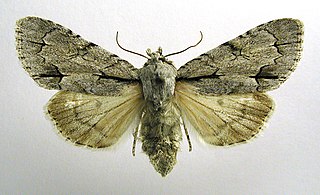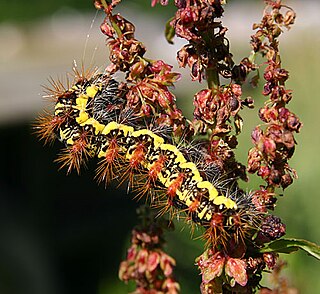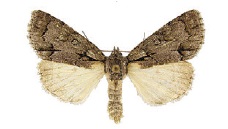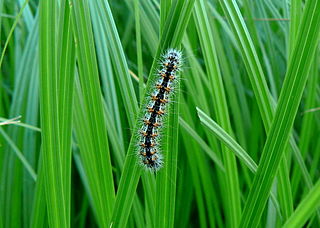
The dark dagger is a moth of the family Noctuidae. The species was first described by Michael Denis and Ignaz Schiffermüller in 1775. It is distributed throughout Europe, Turkey, the Near East, the European part of Russia, southern Siberia, the Ural, the Russian Far East, the Korean Peninsula, China and Japan (Hokkaido).

The grey dagger is a moth of the family Noctuidae.

Acronicta is a genus of noctuid moths containing about 150 species distributed mainly in the temperate Holarctic, with some in adjacent subtropical regions. The genus was erected by Carl Linnaeus in his 1758 10th edition of Systema Naturae. Caterpillars of most Acronicta species are unmistakable, with brightly colored hairy spikes, and often feed quite visibly on common foliate trees. The hairy spikes may contain poison, which cause itchy, painful, swollen rash in humans on contact. The larva of the smeared dagger moth is unusually hairy even for this genus. Acronicta species are generally known as dagger moths, as most have one or more black dagger-shaped markings on their forewing uppersides. But some species have a conspicuous dark ring marking instead.

Acronicta euphorbiae, the sweet gale moth, is a moth of the family Noctuidae. The species was first described by Michael Denis and Ignaz Schiffermüller in 1775.

Acronicta oblinita, the smeared dagger moth or arioch dagger, is a moth of the family Noctuidae. The species was first described by James Edward Smith in 1797. It is found in eastern North America, from Nova Scotia west across Canada to British Columbia, north to Lake Athabasca and south to Florida and Texas.

Boiga barnesii is a species of cat snake endemic to Sri Lanka. It is known as Barnes' cat snake in English and panduru mapila-පදුරු මාපිලා in Sinhala. It is a member of the snake family Colubridae. It is distributed in the lowlands and midlands up to approximately 600 m (2,000 ft) above sea level, with known localities include Matale, Kandy, Gannoruwa, Gampola, Ambagamuwa, Balangoda, Labugama and Sinharaja Rain Forest. Barnes' cat snake is mainly a forest-dwelling species but may occasionally be found in human habitats. It is the smallest cat snake in Sri Lanka and grows up to a maximum of about 600 mm (24 in) in snout-vent length. Being a nocturnal and an arboreal hunter, it mainly feeds on agamid lizards and geckos. The day time is usually spent inside a tree hole or a crevice. It’s a very timid and a mildly venomous snake and rarely attempts to bite.

Acronicta lepusculina, the cottonwood dagger moth, is a moth of the family Noctuidae. The species was first described by Achille Guenée in 1852. It is found in most of eastern North America, west through southern Canada to Vancouver Island and southward.

Acronicta sperata, the hopeful dagger moth, is a moth of the family Noctuidae. The species was first described by Augustus Radcliffe Grote in 1873. It is found in North America from New Brunswick west to the Alberta foothills, south to the District of Columbia, Missouri and in the mountains to Colorado.

Acronicta grisea, the gray dagger, is a moth of the family Noctuidae. The species was first described by Francis Walker in 1856. It is found from the Atlantic to the Pacific coast in southern Canada and the northern United States.

Acronicta hasta, the forked dagger moth, speared dagger moth, cherry dagger moth or dart dagger moth, is a moth of the family Noctuidae. The species was first described by Achille Guenée in 1852. It is found in North America in the eastern deciduous woodlands, ranging west across southern Saskatchewan and Alberta into central southern British Columbia, south to Tennessee, Wisconsin and Kansas.

Acronicta impressa, the impressive dagger moth or willow dagger moth, is a moth of the family Noctuidae. The species was first described by Francis Walker in 1856. It is found from western Canada to north-western Mexico.
Acronicta vulpina, the vulpina dagger moth or miller dagger moth, is a moth of the family Noctuidae. The species was first described by Augustus Radcliffe Grote in 1883. It is found in North America from New York and Newfoundland west to central British Columbia, south to Colorado.

Acronicta vinnula, the delightful dagger moth, is a moth of the family Noctuidae. It is found from Nova Scotia to Florida, west to Texas, north to Wisconsin and Ontario.

Acronicta inclara, the unclear dagger moth, is a moth of the family Noctuidae. The species was first described by John Bernhardt Smith in 1900. It is found in north-eastern North America.

Acronicta modica, the hesitant dagger, is a moth of the family Noctuidae. It is found in eastern North America from Nova Scotia to Florida, west to Oklahoma and Texas.

Acronicta insularis, the cattail caterpillar or Henry's marsh moth, is a moth of the family Noctuidae. The species was first described by Gottlieb August Wilhelm Herrich-Schäffer in 1868. It is found from coast to coast throughout the United States and southern Canada.
Acronicta cinerea is a moth of the family Noctuidae. It is found from northern Germany, Poland, Slovakia, the Czech Republic, the Baltic, southern Finland, Belarus, Ukraine, western Russia up to Uralsk and Guberli.
Enaeta barnesii is a species of sea snail, a marine gastropod mollusk in the family Volutidae, the volutes.









